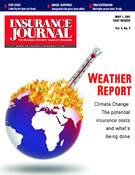Warns falling prices mean profits are at, or are steadily, approaching the cyclical peak
Another report on the insurance industry confirms and details what has been widely acknowledged: a sharp decline in catastrophes in 2006 contributed to improved underwriting results for the year.
The U.S. property/casualty industry posted a $31.2 billion net gain on underwriting for the year. The net gain on underwriting in 2006 stands in stark contrast to the $5.6 billion net loss on underwriting in 2005.
The industry’s overall profitability was the highest in 20 years.
The industry’s positive underwriting results contributed to an increase in its net income after taxes to $63.7 billion in 2006 from $44.2 billion in 2005. Reflecting the increase in net income after taxes, the industry’s rate of return on average policyholders’ surplus (net worth) rose to 14 percent in 2006 from 10.8 percent in 2005, according to Insurance Services Office (ISO) and the Property Casualty Insurers Association of America (PCI).
The figures are consolidated estimates for all private property/
casualty insurers based on reports accounting for at least 96 percent of all business written by private U.S. property/casualty insurers.
Overall profitability
Insurers’ overall profitability as measured by their statutory rate of return on average surplus — net income after taxes divided by average surplus during the year the income was earned — climbed to 14 percent in 2006 from 10.8 percent in 2005. The rate of return for 2006 was the highest since 1986, when it equaled 15.1 percent, but it remained well below the record 23.1 percent statutory rate of return for 1977.
By decade, insurers’ average rate of return climbed from 9.5 percent during the ten years ending 1976 to 13 percent during the ten years ending 1986 but has since fallen to 9.5 percent during the ten years ending 1996 and to 7.9 percent during the ten years ending 2006.
“The insurance industry’s profitability last year compares quite favorably with its own results during the previous 20 years. But escalating competition and falling prices in insurance markets mean that insurers’ profitability is at or near a cyclical peak, even though their rate of return is no better than that of firms in most other industries,” said Michael R. Murray, ISO assistant vice president for financial analysis. “In fact, the insurance industry has a long history of being less profitable than other industries, with insurers’ rate of return being less than that of the Fortune 500 in 21 of the 23 years from 1983, when ISO’s data for the Fortune 500 starts, to 2005. During that span, insurers’ rate of return averaged 8.2 percent — 5.6 percentage points below the 13.8 percent average rate of return for the Fortune 500.”
Catastrophe losses
According to ISO’s Property Claim Services (PCS) unit, direct insured losses from catastrophes dropped to $9.2 billion in 2006 from $61.9 billion in 2005.
“Insurers and residents of coastal states dodged a bullet last year,” noted Murray.
“Much of the improvement in insurers’ underwriting and overall results last year reflects the decline in catastrophe losses from 2005’s record high. Allowing for losses from Katrina, Rita, and Wilma that didn’t emerge until after insurers closed their books for 2005 — and factoring out losses covered by residual market insurers, the Florida Hurricane Catastrophe Fund, and foreign insurers — ISO estimates the catastrophe losses included in private U.S. insurers’ net financial results declined by $21.9 billion to $11.7 billion in 2006 from $33.6 billion in 2005. ISO also estimates that catastrophe-related net loss adjustment expenses declined to $0.6 billion in 2006 from $1.2 billion in 2005, contributing another $0.6 billion to the improvement in underwriting results.”
But experts warned that despite the experience of 2006, catastrophe losses remain a threat.
“While meteorological anomalies confounded the experts and helped the U.S. escape major hurricane strikes in 2006, the threat of more frequent and severe storms, combined with the growing population and the increased value of property in the highest risk areas of the country, means that the threat of enormous losses from natural disasters is a financial problem the nation must deal with,” said Genio Staranczak, PCI’s chief economist.
Underwriting results
The improvement in underwriting results in 2006 reflects both growth in premiums and a decline in loss and loss adjustment expenses.
Net written premiums climbed $18.3 billion to $443.8 billion in 2006 from $425.5 billion in 2005, with written premium growth accelerating to 4.3 percent in 2006 from 0.3 percent in 2005. Net earned premiums rose $18.2 billion last year, increasing to $435.8 billion in 2006 from $417.6 billion in 2005. Earned premium growth accelerated to 4.4 percent in 2006 from 0.9 percent in 2005.
Overall loss and loss adjustment expenses declined $27.9 billion, or 9 percent, to $283.7 billion in 2006 from $311.6 billion in 2005. Non-catastrophe loss and loss adjustment expenses declined $5.4 billion, or 1.9 percent, to $271.4 billion in 2006 from $276.8 billion a year earlier.
Underwriting expenses — primarily acquisition expenses, other expenses associated with underwriting, pricing and servicing insurance policies, and premium taxes — rose $7.7 billion, or 7 percent, to $117.5 billion last year from $109.8 billion in 2005.
The net gain on underwriting in 2006 amounts to 7.2 percent of the $435.8 billion in premiums earned during the period, whereas the net loss on underwriting in 2005 amounted to 1.3 percent of the $417.6 billion in premiums earned during that period.
The combined ratio improved 8.5 percentage points to 92.4 percent in 2006 from 100.9 percent in 2005.
Topics Trends Catastrophe USA Carriers Profit Loss Windstorm Underwriting Property Market Property Casualty Casualty
Was this article valuable?
Here are more articles you may enjoy.


 As Rates Rise, Majority of Homeowners Say Insurance Industry Is in Crisis: Survey
As Rates Rise, Majority of Homeowners Say Insurance Industry Is in Crisis: Survey  Farmers Adjusters Cry Foul Over Workloads, Claims Handling in Letter to Regulators
Farmers Adjusters Cry Foul Over Workloads, Claims Handling in Letter to Regulators  ‘Great Resignation’ Enters Third Year as Workers Embrace AI, Upskilling, PwC Says
‘Great Resignation’ Enters Third Year as Workers Embrace AI, Upskilling, PwC Says  A $29 Billion Weed Market Fights to Diversify Amid Legal Hurdles
A $29 Billion Weed Market Fights to Diversify Amid Legal Hurdles 


